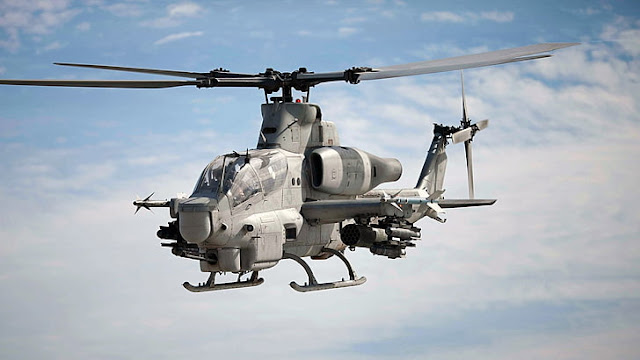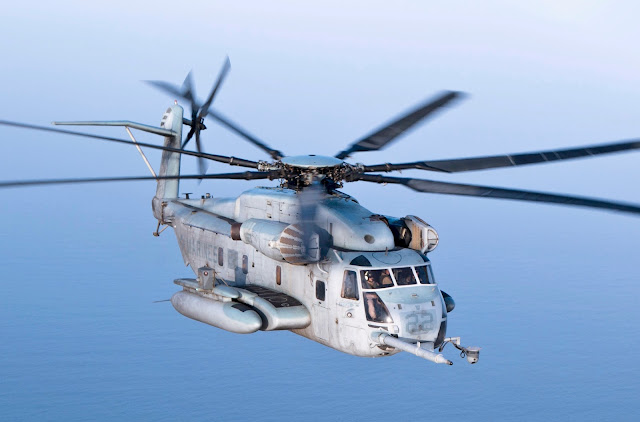Helicopters fit for "The Few, the Proud, the Marines" are essential, as the United States Marine Corps has been involved in some of the bloodiest battles in American history, "from the Halls of Montezuma to the Shores of Tripoli."The United States Marine Corps is a respected military power because of its adaptability. The Marines fight on land, sea, and air. This necessitates the use of helicopters that can adjust to varying weather and terrain.
In the heat of battle, some helicopters must be able to hold their own. These are typically well-armed and have sturdy armor. Yet others are required for urgent missions. These should not only be quick but also very nimble and easy to control. There are also times when the USMC needs to airdrop troops into battle. These must be able to airdrop soldiers or get them out of dangerous situations during rescue missions. They must also have the right amount of speed and armor to be able to survive being shot at.
Marines fight wherever and whenever they are asked to, so they need a lot of different kinds of helicopters like those listed here.
AH-1W Super Cobra

|
| AH-1W Super Cobra - 10 Most Amazing US Marine Corps Helicopters |
By the year 2020, the SuperCobra would have been officially retired from service after more than three decades. Their effectiveness against vehicles has led to their use in a variety of conflicts, from the US invasion of Grenada to the much larger role they played in the Iran-Iraq War.
During the Lebanese Civil War, the SuperCobra was also deployed. In 2016, militants working for the Kurdish PKK used a 9K38 Igla missile launcher to shoot down a Turkish SuperCobra. This showed that the area was vulnerable to attacks from surface-to-air missiles.
The SuperCobra can be armed with many different weapons, such as 20 mm M197 3-barreled Gatling cannons. Rockets, and anti-aircraft missiles, and has a maximum speed of 175 mph, a maximum takeoff weight of 10,000 lbs., and a maximum size of 45 ft. x 9 in. x 10 ft. 9 in.
Bell AH-1Z Viper

|
| Bell AH-1Z Viper - 10 Most Amazing US Marine Corps Helicopters |
Bell is a well-known American company that makes helicopters. The SuperCobra will soon be replaced by the Viper, which is Bell's newest helicopter. In 2010, the US Marine Corps said it was ready for combat and gave the go-ahead for full production.
The sale of American-made Viper aircraft to Pakistan was authorized in 2015. Poland, the Czech Republic, Romania, Morocco, and Bahrain are just some of the countries that have shown interest in or actually made purchases of vipers.
The Viper can be armed with a variety of weapons, including a 120 mm M197 three-barreled rotary cannon, 2.75-in. rockets, and air-to-surface missiles like the AIM-9 Sidewinder and AGM-114 Hellfire. It has a combat range of 125 miles, a cruising speed of 180 mph, and requires a two-person crew to operate.
Bell UH-1 Iroquois
_261_(cropped).jpg)
|
| Bell UH-1 Iroquois |
The "Huey," which is short for "Huey helicopter," was the most famous helicopter of the Vietnam War because it was used a lot during the Easter Offensive in 1972. About 2,800 people lost their lives as a result of the loss of 3,305 UH-1s that were used in Vietnam.
It has been made for armed forces all over the world and has been used in a wide range of conflicts, such as the Falklands War between Argentina and Britain and the 2011 Fukushima Nuclear Disaster in Japan, where two Hueys were used to survey the coast and help with disaster relief.
Hueys were 57 feet long, had a payload capacity of 3,880 pounds, a maximum speed of 135 miles per hour, a range of 315 miles, and were armed with 7.62 mm machine guns and 2.75-inch rocket pods.
Bell AH-1G Cobra

|
| Bell AH-1G Cobra |
This helicopter used to be a mainstay of the U.S. Armed Forces and played a big part in Vietnam. Since the 1990s, this helicopter has been a key part of the US Marine Corps' equipment. It still plays an important role in modern US military operations.
In addition to the United States Marine Corps, other organizations also use these rotorcraft. Israel has also used them, most notably in its wars with Lebanon, and in 2015, it leased some retired Cobras to Jordan to use in its fight against the Islamic State.
Cobras can be armed with M18 7.62 mm Minigun pods, 2.75-inch rockets, 2M129 40-mm grenade launchers, or 27.62 mm multi-barrel Miniguns. With a two-person crew, they can go as fast as 171 miles per hour and have a range of 310 miles. They are 53 feet 5 inches long.
CH-53E Super Stallion

|
| CH-53E Super Stallion |
In the end, Boeing's YCH-53A helicopter prototype, which first appeared in 1964, was chosen over Sikorsky's offering. The Super Stallion's official introduction, however, would not come for quite some time. The first test flight occurred in 1974, but it wasn't widely available until 1981.
The Super Stallions were involved in the rescue of US Army Private Jessica Lynch; two were sent to Mogadishu to airlift Americans out during the Somalian Civil War; and the Super Stallions were also involved in the Gulf War and the 2003 War in Iraq.
The Super Stallion is 99 feet and 0.5 inches tall, can carry between 37 and 55 soldiers, can go up to 170 miles per hour, is powered by three General Electric T64-GE-416, GE-416A, and GE-419 turboshaft engines, and is armed with either two.50 BMG window-mounted GAU-21 machine guns or a 50 BMG (12.7 x 99 mm) ramp-mounted weapons system.
VH-3D Sea King

|
| VH-3D Sea King |
Before 1976, Marine One was called Army One. It is one of the two helicopters used to transport the President of the United States today. Since 1976, it has been serving that function. Two helicopters were changed so that they could both do the same job, and a total of eight were made.
Many countries, including Britain, Brazil, Japan, and others, are still using it 50 years after its initial introduction. During the Vietnam War, the US Navy used it to save people, and the US Marine Corps used it in times of disaster.
Powered by two General Electric T58-GE-10 turboshaft engines, the Sea King can reach speeds of up to 166 miles per hour. It can carry two Mk 46/44 anti-submarine torpedoes and one B-57 nuclear depth charge.
VH-60N White Hawk
The White Hawk, the other USMC helicopter that can serve as "Marine One," was first used by the US Navy when it was introduced in 1985. Having served for decades, the last active-duty White Hawks were sent back to storage in 2015 aboard the USS Theodore Roosevelt.
South Korea, Tunisia, and a number of other countries have bought White Hawks from the international market or are thinking about doing so. As part of an effort to cut government spending, Mexico recently dropped a request for White Hawks.
The White Hawk is 64 feet, eight inches long, and can travel at a top speed of 168 miles per hour thanks to its two General Electric T700-GE-401C turboshaft engines. It has room for three to four people on board, and its arsenal includes two MK 46/50/54 torpedoes, Hellfire missiles, Penguin missiles, and an Advanced Precision Kill Weapon System.
CH-34 Choctaw
.jpg)
|
| CH-34 Choctaw |
More than 2,100 Chocktaws were produced during the 1950s and 1960s, and the French Army Light Aviation flew them in the Algerian War of Independence. They made it easier to move troops by dropping them off in enemy territory. This led to tactics that are still used in helicopter and airmobile warfare today.
They saw service in Vietnam as well. The famous photo essay from the time, "One Ride with Yankee Papa 13," was taken by Larry Burrows. It showed a Choctaw in different stages of a combat mission in which many of the crew were hurt or killed.
The Choctaw was 47 feet, 2 inches in length and could carry anywhere from 12 to 18 soldiers and eight stretchers, depending on the variant, with the help of its Wright R-1820-84 Cyclone engine.
CH-53K King Stallion

|
| CH-53K King Stallion |
The King Stallion, a helicopter that will likely remain a mainstay of the US Marine Corps for decades to come, made its debut with the organization in 2018. It's not just them, either. After seeing it at the Berlin Air Show, both Israel and Japan said they were interested in buying it.
However, it appears that Germany is shifting its position. The German Ministry of Defense has officially canceled its order for 45–60 helicopters because of how much they cost.
The King Stallion is 99 feet long, can carry 30 people plus a general payload of up to 35,000 pounds, and can reach top speeds of up to 200 miles per hour thanks to its three General Electric T408 (GE38-1B) turboshaft engines.
Bell Boeing V-22 Osprey

|
| Bell Boeing V-22 Osprey |
The Osprey is important to the United States Marine Corps because it is a key transport helicopter. In the aftermath of President Carter's failed 1980 mission to Iran during the Iranian Hostage Crisis, this was created. Recent problems with US helicopters have highlighted the importance of replacing the current fleet.
However, it took a very long time to develop this helicopter; the first test flight wasn't until 1989, and it wasn't put into service until 2007. Since then, the Osprey's deployment to Iraq and Afghanistan has increased dramatically.
The Osprey is 57 feet, four inches in length, can travel at speeds of up to 316 miles per hour thanks to its two Rolls-Royce T406-AD-400 turboprop/turboshaft engines, and has a payload capacity of up to 20,000 pounds, with room for 24 passengers in seats or 32 in the cargo hold.

